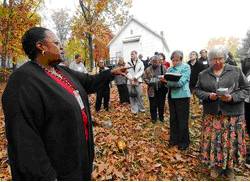Collection Name
About
Standing on hallowed ground
Originally published November 17, 2007
By Nicholas C. Stern
News-Post Staff
BUCKEYSTOWN -- Looking out this week at the barns that dot the rolling landscape in southern Frederick County, Mary Harris narrated a story about freed black slaves.
After emancipation in the 1860s, freed slaves began taking up residence in the shacks where they had dried tobacco, Harris said.
Harris, a local expert on black history from Adamstown, whose ancestors were also freed slaves, was among a group of regional historians and advocates who participated in a workshop at the Bishop Claggett Center in Buckeystown.
The Journey Through Hallowed Ground Partnerships' African American Heritage committee met to discuss ongoing research efforts designed to educate the public about the historical impact blacks have had in the Journey's corridor, an area stretching 175 miles along U.S. 15, from Gettysburg to Monticello, Va.
The workshop, whose participants included representatives from the Frederick County-based African American Resources-Cultural and Heritage, devised strategies to list black historic sites on the National Register of Historic Places.
Deborah A. Lee, an independent historian from Virginia who consults with the Journey Through Hallowed Ground, said the goal is to expand the amount of black history reflected on the National Register. That will be accomplished in two ways.
The first is amending existing nominations to include recently researched and documented black history, she said.
An example is the country home of Frisby Tilghman, one of the largest slave holders in Washington County.
James W. C. Pennington also lived in Tilghman's manor house, on Md. 65 south of Hagerstown. Pennington escaped slavery and went on to become a minister, author and influential abolitionist, Lee said.
The second method, Lee said, is to nominate more black historical sites to the National Register.
One possible candidate is Sunnyside Church and schoolhouse, in southwest Frederick County, near Jefferson.
Regional congregations, historical societies and individuals joining efforts to nominate such sites under a specific theme, like churches, would decrease the difficulty involved in placing them, one by one, on the register, Lee said.
In the afternoon, Dean Herrin, the National Park Service coordinator for Frederick Community College's Catoctin Center for Regional Studies, led a scenic bus tour to other sites throughout Frederick County.
These included historic black neighborhoods in downtown Frederick; West All Saints Street and Shab Row along East Street, the first all-black high school in the county, Lincoln High, and the Laboring Sons Cemetery.
David Key, a member of African American Resources-Cultural and Heritage, said he attended Lincoln in the '50s. Lincoln, which opened in 1928, remained segregated until 1962, even though other schools in the country began desegregating in 1958, Key said.
The Monocacy National Battlefield in Urbana was another stop.
The Best farm, a parcel of a larger plantation called L'Hermitage, once housed as many as 90 slaves, an unusually high number for Frederick County, said Joy Beasley, cultural resources manager at the National Park Service.
Another memorable site is a cemetery in Urbana, where a gravestone with the distinctive designs carved by Sebastian "Boss" Hammond still stands.
The tale, as told by Herrin, of Hammond's harrowing journey from slave to thriving freedman, able to purchase his entire family's freedom through his craft, to the crushing debts he owed at his death, left the audience speechless.
These types of stories, pertaining to local places and events, are the kind the Journey's African American Heritage committee is trying to get out to the community.
"It's important to tell the history (of our area)," Key said, "good or bad, because we become better people."
Reprinted with permission of the Frederick News-Post and Randall Family, LCC as published on November 17, 2007 at FrederickPost.com
